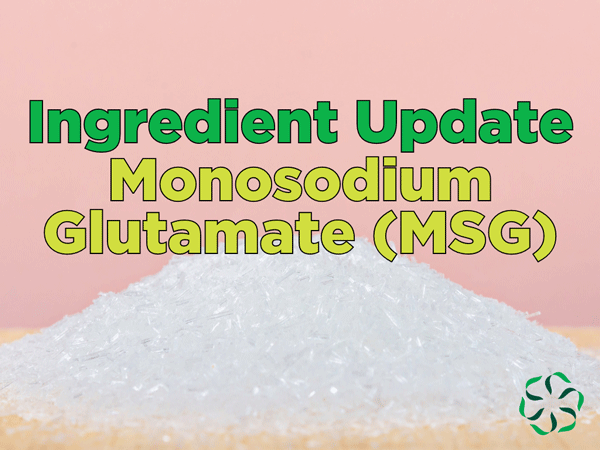Are you familiar with the ingredient monosodium glutamate (MSG)? In this post, we’ll discuss the safety of MSG and explore common misconceptions about this ingredient.
Updated April 17, 2023
What is monosodium glutamate (MSG)?
Monosodium glutamate, commonly known as MSG, is an ingredient that enhances the flavor of foods, specifically, the umami, or savory, taste associated with many of our favorite dishes.
How do our bodies process MSG?
MSG breaks down into the sodium salt of glutamic acid. Glutamic acid is a common nonessential amino acid, meaning our bodies naturally produce this amino acid.
While we may be familiar with sodium salts, glutamic acid is also found in everyday ingredients such as tomatoes, carrots, onions, and more.
What foods contain MSG? Is MSG naturally occurring?
Many people associate MSG with American-style Chinese food dishes, but we also find it in other foods, such as soups and gravies.
MSG is naturally occurring in many vegetables and fungi. Manufacturers can derive it from plants and vegetables, typically corn and beets, and added to many common food products such as bouillon cubes, processed meats, and more.
MSG and Chinese Restaurant Syndrome
During the mid-20th century, some individuals reported a series of adverse health impacts, including headaches, numbness, palpitations, and general weakness after consuming foods from Chinese food restaurants known to cook with MSG. As a result, MSG use became closely associated with Chinese food, and the reported adverse health impacts became known as “Chinese Restaurant Syndrome” (CRS).
While initial studies on the CRS phoneme showed adverse health impacts, these studies were not replicable. Further, blinded research, where participants and researchers did not know who had consumed MSG in their diet and who received average doses of MSG, did not show negative health impacts (1,2,3,4).
Can MSG cause adverse health impacts?
A U.S. Food and Drug Administration (FDA) study where people consumed large doses of MSG (3 grams or more) without food did show mild, short-term, transit health impacts, including:
- Headache
- Numbness
- Flushing
- Tingling
- Palpitations
By contrast, a typical dose of MSG found in food contains less than 0.5 grams of MSG, making it unlikely people would experience short-term negative health impacts when consumed in a typical setting.
Note, while extremely rare, it is possible for people to have a food allergy or sensitivity to MSG, but this is an uncommon reaction to the ingredient (1,2).
Is MSG safe?
MSG is a GRAS ingredient and is recognized as being safe, as long as we consume it moderately.
We only need to avoid MSG in a typical food setting if we have a known allergy or sensitivity (1,2).
How can I avoid MSG?
If you choose not to consume MSG, there are a few things you can do to avoid it:
- Read food labels carefully: MSG must be listed on food labels, so you can easily identify foods that contain it.
- Avoid processed foods: MSG is a common ingredient in processed foods, so avoiding these foods can help you reduce your intake of MSG.
- Cook at home: When you cook at home, you have control over the ingredients that go into your food, so you can avoid adding MSG.
If you have any questions or concerns about MSG, it is always best to talk to your doctor.
The good news.
MSG is a safe and effective flavor enhancer we can add to our favorite savory foods.

